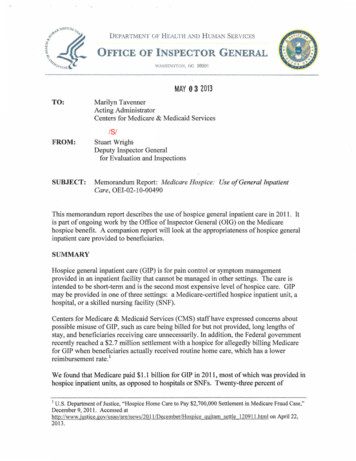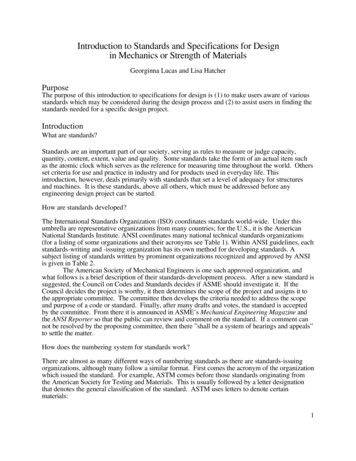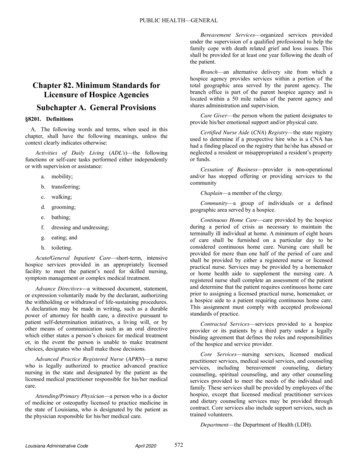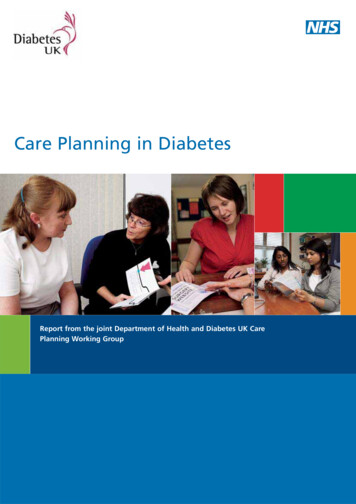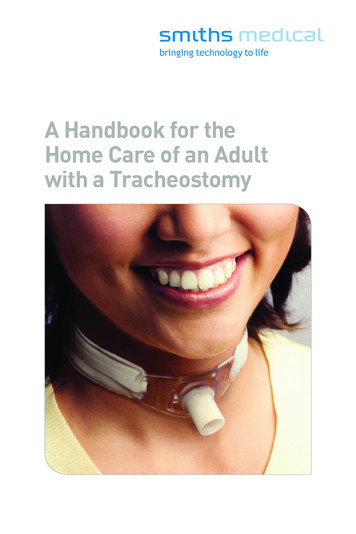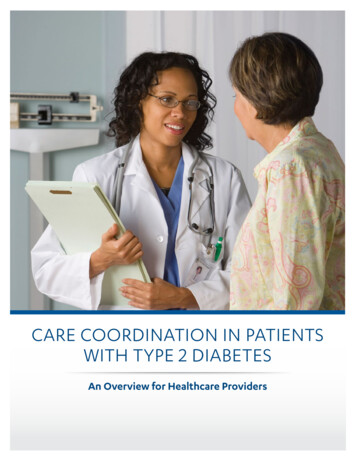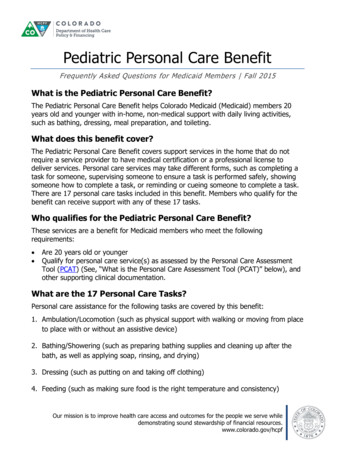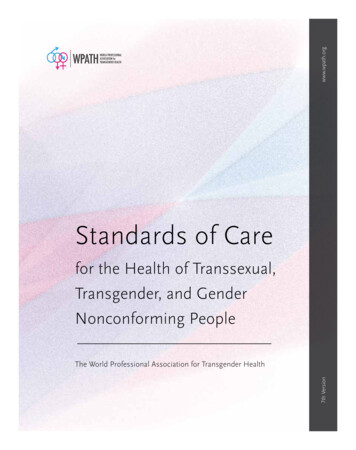
Transcription
www.wpath.orgStandards of Carefor the Health of Transsexual,Transgender, and GenderNonconforming People7th VersionThe World Professional Association for Transgender HealthStandards of Care 1c.indd 19/20/11 9:43 PM
Standards of Care 1c.indd 29/20/11 9:43 PM
Standards of Carefor the Health of Transsexual,Transgender, and GenderNonconforming PeopleThe World Professiona Association for Transgender Health7th Version1 www.wpath.org1 This is the seventh version of the Standards of Care. The original SOC were published in 1979. Previous revisions were in 1980, 1981,1990, 1998, and 2001.Standards of Care 1c.indd 39/20/11 9:43 PM
Standards of Care 1c.indd 49/20/11 9:43 PM
The Standards of Care7th VersionTable of ContentsI. Purpose and Use of the Standards of Care . . . . . . . . . . . . . . . . . . . . . . . . . . . . . . . . . . . . . . 1II. Global Applicability of the Standards of Care . . . . . . . . . . . . . . . . . . . . . . . . . . . . . . . . . . . . 3III. The Difference between Gender Nonconformity and Gender Dysphoria . . . . . . . . . . . . . . 4IV. Epidemiologic Considerations . . . . . . . . . . . . . . . . . . . . . . . . . . . . . . . . . . . . . . . . . . . . . . . . 6V. Overview of Therapeutic Approaches for Gender Dysphoria. . . . . . . . . . . . . . . . . . . . . . . . 8VI. Assessment and Treatment of Children and Adolescents with Gender Dysphoria . . . . . 10VII. Mental Health . . . . . . . . . . . . . . . . . . . . . . . . . . . . . . . . . . . . . . . . . . . . . . . . . . . . . . . . . . . 21VIII. Hormone Therapy . . . . . . . . . . . . . . . . . . . . . . . . . . . . . . . . . . . . . . . . . . . . . . . . . . . . . . . . 33IX. Reproductive Health. . . . . . . . . . . . . . . . . . . . . . . . . . . . . . . . . . . . . . . . . . . . . . . . . . . . . . . 50X. Voice and Communication Therapy. . . . . . . . . . . . . . . . . . . . . . . . . . . . . . . . . . . . . . . . . . . 52XI. Surgery. . . . . . . . . . . . . . . . . . . . . . . . . . . . . . . . . . . . . . . . . . . . . . . . . . . . . . . . . . . . . . . . . . 54XII. Postoperative Care and Follow-Up. . . . . . . . . . . . . . . . . . . . . . . . . . . . . . . . . . . . . . . . . . . . 64XIII. Lifelong Preventive and Primary Care . . . . . . . . . . . . . . . . . . . . . . . . . . . . . . . . . . . . . . . . . 65XIV. Applicability of the Standards of Care to People Living in Institutional Environments . . . 67XV. Applicability of the Standards of Care to People With Disorders of Sex Development . . . 69References. . . . . . . . . . . . . . . . . . . . . . . . . . . . . . . . . . . . . . . . . . . . . . . . . . . . . . . . . . . . . . . . . 72Appendices:A. Glossary. . . . . . . . . . . . . . . . . . . . . . . . . . . . . . . . . . . . . . . . . . . . . . . . . . . . . . . . . . . . . . . . . 95B. Overview of Medical Risks of Hormone Therapy . . . . . . . . . . . . . . . . . . . . . . . . . . . . . . . . 97C. Summary of Criteria for Hormone Therapy and Surgeries. . . . . . . . . . . . . . . . . . . . . . . . 104D. Evidence for Clinical Outcomes of Therapeutic Approaches. . . . . . . . . . . . . . . . . . . . . . 107E. Development Process for the Standards of Care, Version 7. . . . . . . . . . . . . . . . . . . . . . . . 109World Professional Association for Transgender HealthStandards of Care 1c.indd 1i9/20/11 9:43 PM
Standards of Care 1c.indd 29/20/11 9:43 PM
The Standards of Care7th VersionIPurpose and Use of the Standards of CareThe World Professional Association for Transgender Health (WPATH)1 is an international,multidisciplinary, professional association whose mission is to promote evidence-based care,education, research, advocacy, public policy, and respect for transgender health. The vision ofWPATH is to bring together diverse professionals dedicated to developing best practices andsupportive policies worldwide that promote health, research, education, respect, dignity, andequality for transsexual, transgender, and gender nonconforming people in all cultural settings.One of the main functions of WPATH is to promote the highest standards of health care forindividuals through the articulation of Standards of Care (SOC) for the Health of Transsexual,Transgender, and Gender Nonconforming People. The SOC are based on the best available scienceand expert professional consensus.2 Most of the research and experience in this field comes froma North American and Western European perspective; thus, adaptations of the SOC to other partsof the world are necessary. Suggestions for ways of thinking about cultural relativity and culturalcompetence are included in this version of the SOC.The overall goal of the SOC is to provide clinical guidance for health professionals to assisttranssexual, transgender, and gender nonconforming people with safe and effective pathways toachieving lasting personal comfort with their gendered selves, in order to maximize their overallhealth, psychological well-being, and self-fulfillment. This assistance may include primary care,gynecologic and urologic care, reproductive options, voice and communication therapy, mentalhealth services (e.g., assessment, counseling, psychotherapy), and hormonal and surgicaltreatments. While this is primarily a document for health professionals, the SOC may also beused by individuals, their families, and social institutions to understand how they can assist withpromoting optimal health for members of this diverse population.WPATH recognizes that health is dependent upon not only good clinical care but also social andpolitical climates that provide and ensure social tolerance, equality, and the full rights of citizenship.Health is promoted through public policies and legal reforms that promote tolerance and equity1 Formerly the Harry Benjamin International Gender Dysphoria Association2 Standards of Care (SOC), Version 7 represents a significant departure from previous versions. Changes in this version are basedupon significant cultural shifts, advances in clinical knowledge, and appreciation of the many health care issues that can arise fortranssexual, transgender, and gender nonconforming people beyond hormone therapy and surgery (Coleman, 2009a, b, c, d).World Professional Association for Transgender HealthStandards of Care 1c.indd 119/20/11 9:43 PM
The Standards of Care7th Versionfor gender and sexual diversity and that eliminate prejudice, discrimination, and stigma. WPATH iscommitted to advocacy for these changes in public policies and legal reforms.The Standards of Care Are Flexible Clinical GuidelinesThe SOC are intended to be flexible in order to meet the diverse health care needs of transsexual,transgender, and gender nonconforming people. While flexible, they offer standards for promotingoptimal health care and guiding the treatment of people experiencing gender dysphoria – broadlydefined as discomfort or distress that is caused by a discrepancy between a person’s genderidentity and that person’s sex assigned at birth (and the associated gender role and/or primary andsecondary sex characteristics) (Fisk, 1974; Knudson, De Cuypere, & Bockting, 2010b).As for all previous versions of the SOC, the criteria put forth in this document for hormone therapyand surgical treatments for gender dysphoria are clinical guidelines; individual health professionalsand programs may modify them. Clinical departures from the SOC may come about because of apatient’s unique anatomic, social, or psychological situation; an experienced health professional’sevolving method of handling a common situation; a research protocol; lack of resources in variousparts of the world; or the need for specific harm reduction strategies. These departures shouldbe recognized as such, explained to the patient, and documented through informed consent forquality patient care and legal protection. This documentation is also valuable for the accumulationof new data, which can be retrospectively examined to allow for health care – and the SOC – toevolve.The SOC articulate standards of care but also acknowledge the role of making informed choicesand the value of harm reduction approaches. In addition, this version of the SOC recognizes andvalidates various expressions of gender that may not necessitate psychological, hormonal, or surgicaltreatments. Some patients who present for care will have made significant self-directed progresstowards gender role changes, transition, or other resolutions regarding their gender identity orgender dysphoria. Other patients will require more intensive services. Health professionals can usethe SOC to help patients consider the full range of health services open to them, in accordance withtheir clinical needs and goals for gender expression.2Standards of Care 1c.indd 2World Professional Association for Transgender Health9/20/11 9:43 PM
The Standards of Care7th VersionIIGlobal Applicability of the Standards of CareWhile the SOC are intended for worldwide use, WPATH acknowledges that much of the recordedclinical experience and knowledge in this area of health care is derived from North Americanand Western European sources. From place to place, both across and within nations, there aredifferences in all of the following: social attitudes towards transsexual, transgender, and gendernonconforming people; constructions of gender roles and identities; language used to describedifferent gender identities; epidemiology of gender dysphoria; access to and cost of treatment;therapies offered; number and type of professionals who provide care; and legal and policy issuesrelated to this area of health care (Winter, 2009).It is impossible for the SOC to reflect all of these differences. In applying these standards to othercultural contexts, health professionals must be sensitive to these differences and adapt the SOCaccording to local realities. For example, in a number of cultures, gender nonconforming peopleare found in such numbers and living in such ways as to make them highly socially visible (Peletz,2006). In settings such as these, it is common for people to initiate a change in their genderexpression and physical characteristics while in their teens, or even earlier. Many grow up and livein a social, cultural, and even linguistic context quite unlike that of Western cultures. Yet almostall experience prejudice (Peletz, 2006; Winter, 2009). In many cultures, social stigma towardsgender nonconformity is widespread and gender roles are highly prescriptive (Winter et al., 2009).Gender nonconforming people in these settings are forced to be hidden, and therefore may lackopportunities for adequate health care (Winter, 2009).The SOC are not intended to limit efforts to provide the best available care to all individuals.Health professionals throughout the world – even in areas with limited resources and trainingopportunities – can apply the many core principles that undergird the SOC. These principlesinclude the following: Exhibit respect for patients with nonconforming gender identities (do notpathologize differences in gender identity or expression); provide care (or refer to knowledgeablecolleagues) that affirms patients’ gender identities and reduces the distress of gender dysphoria,when present; become knowledgeable about the health care needs of transsexual, transgender, andgender nonconforming people, including the benefits and risks of treatment options for genderdysphoria; match the treatment approach to the specific needs of patients, particularly their goalsfor gender expression and need for relief from gender dysphoria; facilitate access to appropriatecare; seek patients’ informed consent before providing treatment; offer continuity of care; and beprepared to support and advocate for patients within their families and communities (schools,workplaces, and other settings).World Professional Association for Transgender HealthStandards of Care 1c.indd 339/20/11 9:43 PM
The Standards of Care7th VersionTerminology is culturally and time-dependent and is rapidly evolving. It is important to userespectful language in different places and times, and among different people. As the SOC aretranslated into other languages, great care must be taken to ensure that the meanings of termsare accurately translated. Terminology in English may not be easily translated into other languages,and vice versa. Some languages do not have equivalent words to describe the various terms withinthis document; hence, translators should be cognizant of the underlying goals of treatment andarticulate culturally applicable guidance for reaching those goals.IIIThe Difference Between GenderNonconformity and Gender DysphoriaBeing Transsexual, Transgender, or Gender NonconformingIs a Matter of Diversity, Not PathologyWPATH released a statement in May 2010 urging the de-psychopathologization of gendernonconformity worldwide (WPATH Board of Directors, 2010). This statement noted that “theexpression of gender characteristics, including identities, that are not stereotypically associatedwith one’s assigned sex at birth is a common and culturally-diverse human phenomenon [that]should not be judged as inherently pathological or negative.”Unfortunately, there is stigma attached to gender nonconformity in many societies around theworld. Such stigma can lead to prejudice and discrimination, resulting in “minority stress” (I. H.Meyer, 2003). Minority stress is unique (additive to general stressors experienced by all people),socially based, and chronic, and may make transsexual, transgender, and gender nonconformingindividuals more vulnerable to developing mental health concerns such as anxiety and depression(Institute of Medicine, 2011). In addition to prejudice and discrimination in society at large, stigmacan contribute to abuse and neglect in one’s relationships with peers and family members, whichin turn can lead to psychological distress. However, these symptoms are socially induced and arenot inherent to being transsexual, transgender, or gender nonconforming.4Standards of Care 1c.indd 4World Professional Association for Transgender Health9/20/11 9:43 PM
The Standards of Care7th VersionGender Nonconformity Is Not the Same as Gender DysphoriaGender nonconformity refers to the extent to which a person’s gender identity, role, or expressiondiffers from the cultural norms prescribed for people of a particular sex (Institute of Medicine,2011). Gender dysphoria refers to discomfort or distress that is caused by a discrepancy betweena person’s gender identity and that person’s sex assigned at birth (and the associated gender roleand/or primary and secondary sex characteristics) (Fisk, 1974; Knudson, De Cuypere, & Bockting,2010b). Only some gender nonconforming people experience gender dysphoria at some point intheir lives.Treatment is available to assist people with such distress to explore their gender identity and find agender role that is comfortable for them (Bockting & Goldberg, 2006). Treatment is individualized:What helps one person alleviate gender dysphoria might be very different from what helpsanother person. This process may or may not involve a change in gender expression or bodymodifications. Medical treatment options include, for example, feminization or masculinizationof the body through hormone therapy and/or surgery, which are effective in alleviating genderdysphoria and are medically necessary for many people. Gender identities and expressions arediverse, and hormones and surgery are just two of many options available to assist people withachieving comfort with self and identity.Gender dysphoria can in large part be alleviated through treatment (Murad et al., 2010). Hence,while transsexual, transgender, and gender nonconforming people may experience genderdysphoria at some point in their lives, many individuals who receive treatment will find a genderrole and expression that is comfortable for them, even if these differ from those associated withtheir sex assigned at birth, or from prevailing gender norms and expectations.Diagnoses Related to Gender DysphoriaSome people experience gender dysphoria at such a level that the distress meets criteria for aformal diagnosis that might be classified as a mental disorder. Such a diagnosis is not a license forstigmatization or for the deprivation of civil and human rights. Existing classification systems suchas the Diagnostic Statistical Manual of Mental Disorders (DSM) (American Psychiatric Association,2000) and the International Classification of Diseases (ICD) (World Health Organization, 2007)define hundreds of mental disorders that vary in onset, duration, pathogenesis, functional disability,and treatability. All of these systems attempt to classify clusters of symptoms and conditions, notthe individuals themselves. A disorder is a description of something with which a person mightstruggle, not a description of the person or the person’s identity.World Professional Association for Transgender HealthStandards of Care 1c.indd 559/20/11 9:43 PM
The Standards of Care7th VersionThus, transsexual, transgender, and gender nonconforming individuals are not inherentlydisordered. Rather, the distress of gender dysphoria, when present, is the concern that might bediagnosable and for which various treatment options are available. The existence of a diagnosis forsuch dysphoria often facilitates access to health care and can guide further research into effectivetreatments.Research is leading to new diagnostic nomenclatures, and terms are changing in both the DSM(Cohen-Kettenis & Pfäfflin, 2010; Knudson, De Cuypere, & Bockting, 2010b; Meyer-Bahlburg, 2010;Zucker, 2010) and the ICD. For this reason, familiar terms are employed in the SOC and definitionsare provided for terms that may be emerging. Health professionals should refer to the most currentdiagnostic criteria and appropriate codes to apply in their practice areas.IVEpidemiologic ConsiderationsFormal epidemiologic studies on the incidence3 and prevalence4 of transsexualism specifically ortransgender and gender nonconforming identities in general have not been conducted, and effortsto achieve realistic estimates are fraught with enormous difficulties (Institute of Medicine, 2011;Zucker & Lawrence, 2009). Even if epidemiologic studies established that a similar proportion oftranssexual, transgender, or gender nonconforming people existed all over the world, it is likely thatcultural differences from one country to another would alter both the behavioral expressions ofdifferent gender identities and the extent to which gender dysphoria – distinct from one’s genderidentity – is actually occurring in a population. While in most countries, crossing normative genderboundaries generates moral censure rather than compassion, there are examples in certain culturesof gender nonconforming behaviors (e.g., in spiritual leaders) that are less stigmatized and evenrevered (Besnier, 1994; Bolin, 1988; Chiñas, 1995; Coleman, Colgan, & Gooren, 1992; Costa &Matzner, 2007; Jackson & Sullivan, 1999; Nanda, 1998; Taywaditep, Coleman, & Dumronggittigule,1997).For various reasons, researchers who have studied incidence and prevalence have tended to focuson the most easily counted subgroup of gender nonconforming individuals: transsexual individualswho experience gender dysphoria and who present for gender-transition-related care at specialistgender clinics (Zucker & Lawrence, 2009). Most studies have been conducted in European3 incidence—the number of new cases arising in a given period (e.g., a year)4 prevalence—the number of individuals having a condition, divided by the number of people in the general population6Standards of Care 1c.indd 6World Professional Association for Transgender Health9/20/11 9:43 PM
The Standards of Care7th Versioncountries such as Sweden (Wålinder, 1968, 1971), the United Kingdom (Hoenig & Kenna, 1974),the Netherlands (Bakker, Van Kesteren, Gooren, & Bezemer, 1993; Eklund, Gooren, & Bezemer,1988; van Kesteren, Gooren, & Megens, 1996), Germany (Weitze & Osburg, 1996), and Belgium(De Cuypere et al., 2007). One was conducted in Singapore (Tsoi, 1988).De Cuypere and colleagues (2007) reviewed such studies, as well as conducted their own. Together,those studies span 39 years. Leaving aside two outlier findings from Pauly in 1968 and Tsoi in 1988,ten studies involving eight countries remain. The prevalence figures reported in these ten studiesrange from 1:11,900 to 1:45,000 for male-to-female individuals (MtF) and 1:30,400 to 1:200,000for female-to-male (FtM) individuals. Some scholars have suggested that the prevalence is muchhigher, depending on the methodology used in the research (for example, Olyslager & Conway,2007).Direct comparisons across studies are impossible, as each differed in their data collection methodsand in their criteria for documenting a person as transsexual (e.g., whether or not a person hadundergone genital reconstruction, versus had initiated hormone therapy, versus had come to theclinic seeking medically-supervised transition services). The trend appears to be towards higherprevalence rates in the more recent studies, possibly indicating increasing numbers of peopleseeking clinical care. Support for this interpretation comes from research by Reed and colleagues(2009), who reported a doubling of the numbers of people accessing care at gender clinics in theUnited Kingdom every five or six years. Similarly, Zucker and colleagues (2008) reported a four- tofive-fold increase in child and adolescent referrals to their Toronto, Canada clinic over a 30-yearperiod.The numbers yielded by studies such as these can be considered minimum estimates at best. Thepublished figures are mostly derived from clinics where patients met criteria for severe genderdysphoria and had access to health care at those clinics. These estimates do not take into accountthat treatments offered in a particular clinic setting might not be perceived as affordable, useful, oracceptable by all self-identified gender dysphoric individuals in a given area. By counting only thosepeople who present at clinics for a specific type of treatment, an unspecified number of genderdysphoric individuals are overlooked.Other clinical observations (not yet firmly supported by systematic study) support the likelihood of ahigher prevalence of gender dysphoria: (i) Previously unrecognized gender dysphoria is occasionallydiagnosed when patients are seen with anxiety, depression, conduct disorder, substance abuse,dissociative identity disorders, borderline personality disorder, sexual disorders, and disorders ofsex development (Cole, O’Boyle, Emory, & Meyer III, 1997). (ii) Some crossdressers, drag queens/kings or female/male impersonators, and gay and lesbian individuals may be experiencing genderdysphoria (Bullough & Bullough, 1993). (iii) The intensity of some people’s gender dysphoriafluctuates below and above a clinical threshold (Docter, 1988). (iv) Gender nonconformity amongFtM individuals tends to be relatively invisible in many cultures, particularly to Western healthWorld Professional Association for Transgender HealthStandards of Care 1c.indd 779/20/11 9:43 PM
The Standards of Care7th Versionprofessionals and researchers who have conducted most of the studies on which the currentestimates of prevalence and incidence are based (Winter, 2009).Overall, the existing data should be considered a starting point, and health care would benefit frommore rigorous epidemiologic study in different locations worldwide.VOverview of Therapeutic Approaches forGender DysphoriaAdvancements in the Knowledge andTreatment of Gender DysphoriaIn the second half of the 20th century, awareness of the phenomenon of gender dysphoria increasedwhen health professionals began to provide assistance to alleviate gender dysphoria by supportingchanges in primary and secondary sex characteristics through hormone therapy and surgery, alongwith a change in gender role. Although Harry Benjamin already acknowledged a spectrum ofgender nonconformity (Benjamin, 1966), the initial clinical approach largely focused on identifyingwho was an appropriate candidate for sex reassignment to facilitate a physical change from maleto female or female to male as completely as possible (e.g., Green & Fleming, 1990; Hastings,1974). This approach was extensively evaluated and proved to be highly effective. Satisfactionrates across studies ranged from 87% of MtF patients to 97% of FtM patients (Green & Fleming,1990), and regrets were extremely rare (1-1.5% of MtF patients and 1% of FtM patients; Pfäfflin,1993). Indeed, hormone therapy and surgery have been found to be medically necessary to alleviategender dysphoria in many people (American Medical Association, 2008; Anton, 2009; The WorldProfessional Association for Transgender Health, 2008).As the field matured, health professionals recognized that while many individuals need bothhormone therapy and surgery to alleviate their gender dysphoria, others need only one of thesetreatment options and some need neither (Bockting & Goldberg, 2006; Bockting, 2008; Lev, 2004).Often with the help of psychotherapy, some individuals integrate their trans- or cross-genderfeelings into the gender role they were assigned at birth and do not feel the need to feminize ormasculinize their body. For others, changes in gender role and expression are sufficient to alleviate8Standards of Care 1c.indd 8World Professional Association for Transgender Health9/20/11 9:43 PM
The Standards of Care7th Versiongender dysphoria. Some patients may need hormones, a possible change in gender role, but notsurgery; others may need a change in gender role along with surgery, but not hormones. In otherwords, treatment for gender dysphoria has become more individualized.As a generation of transsexual, transgender, and gender nonconforming individuals has come ofage – many of whom have benefitted from different therapeutic approaches – they have becomemore visible as a community and demonstrated considerable diversity in their gender identities,roles, and expressions. Some individuals describe themselves not as gender nonconformingbut as unambiguously cross-sexed (i.e., as a member of the other sex; Bockting, 2008). Otherindividuals affirm their unique gender identity and no longer consider themselves either male orfemale (Bornstein, 1994; Kimberly, 1997; Stone, 1991; Warren, 1993). Instead, they may describetheir gender identity in specific terms such as transgender, bigender, or genderqueer, affirming theirunique experience that may transcend a male/female binary understanding of gender (Bockting,2008; Ekins & King, 2006; Nestle, Wilchins, & Howell, 2002). They may not experience their processof identity affirmation as a “transition,” because they never fully embraced the gender role they wereassigned at birth or because they actualize their gender identity, role, and expression in a way thatdoes not involve a change from one gender role to another. For example, some youth identifying asgenderqueer have always experienced their gender identity and role as such (genderqueer). Greaterpublic visibility and awareness of gender diversity (Feinberg, 1996) has further expanded optionsfor people with gender dysphoria to actualize an identity and find a gender role and expression thatis comfortable for them.Health professionals can assist gender dysphoric individuals with affirming their gender identity,exploring different options for expression of that identity, and making decisions about medicaltreatment options for alleviating gender dysphoria.Options for Psychological and MedicalTreatment of Gender DysphoriaFor individuals seeking care for gender dysphoria, a variety of therapeutic options can be considered.The number and type of interventions applied and the order in which these take place may differfrom person to person (e.g., Bockting, Knudson, & Goldberg, 2006; Bolin, 1994; Rachlin, 1999;Rachlin, Green, & Lombardi, 2008; Rachlin, Hansbury, & Pardo, 2010). Treatments options includethe following: Changes in gender expression and role (which may involve living part time or full time inanother gender role, consistent with one’s gender identity); Hormone therapy to feminize or masculinize the body;World Professional Association for Transgender HealthStandards of Care 1c.indd 999/20/11 9:43 PM
The Standards of Care7th Version Surgery to change primary and/or secondary sex characteristics (e.g., breasts/chest, externaland/or internal genitalia, facial features, body contouring); Psychotherapy (individual, couple, family, or group) for purposes such as exploring genderidentity, role, and expression; addressing the negative impact of gender dysphoria and stigmaon mental health; alleviating internalized transphobia; enhancing social and peer support;improving body image; or promoting resilience.Options for Social Support and Changes in Gender ExpressionIn addition (or as an alternative) to the psychological and medical treatment options describedabove, other options can be considered to help alleviate gender dysphoria, for example: Offline and online peer support resources, groups, or community organizations that provideavenues for social support and advocacy; Offline and online support resources for families and friends; Voice and communication therapy to help individuals develop verbal and non-verbal communication skills that facilitate comfort with their gender identity; Hair removal through electrolysis, laser treatment, or waxing; Breast binding or padding, genital tucking or penile prostheses, padding of hips or buttocks; Changes in name and gender marker on identity documents.VIAssessment and Treatment of Children andAdolescents with Gender DysphoriaThere are a number of differences in the phenomenology, developmental course, and treatmentapproaches for ge
1 The Standards of Care 7th Version World Professional Association for Transgender Health I Purpose and Use of the standards of Care The World Professional Association for Transgender Health (WPATH)1 is an international, multidisciplinary, professional ass



